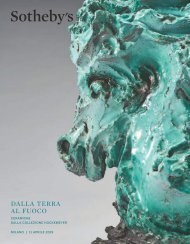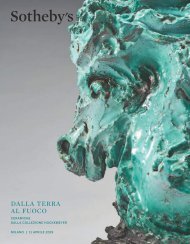! Sotheby's - Hockemeyer Ceramic Collection Lots 1-28
Create successful ePaper yourself
Turn your PDF publications into a flip-book with our unique Google optimized e-Paper software.
19<br />
Lucio Fontana<br />
1899 - 1968<br />
Battaglia<br />
firmato e datato ‘50 albisola sul retro<br />
ceramica smaltata policroma<br />
cm 13x89,5x88<br />
PROVENIENZA(E)<br />
Studio Gian Galeazzo Visconti, Milano<br />
Ivi acquistato dall’attuale proprietario<br />
ESPOSIZIONE(I)<br />
Roma, Galleria Il triangolo, 1961, p. 8, illustrato<br />
Londra, Estorick <strong>Collection</strong> of Modern Italian<br />
Art, Terra Incognita: Italy’s <strong>Ceramic</strong> Revival,<br />
2009<br />
BIBLIOGRAFIA<br />
Walter Dorwin Teague, ‘Italian Shopping Trip -<br />
Twelve American museums send out a battery<br />
of buyers’, in “Interiors”, 1950, vol. 10, p. 144,<br />
illustrato<br />
The <strong>Hockemeyer</strong> <strong>Collection</strong>. 20th Century<br />
Italian <strong>Ceramic</strong> Art, Monaco di Baviera 2009,<br />
pp. 86-87, illustrato a colori<br />
L’opera è registrata presso la Fondazione Lucio<br />
Fontana, Milano, con il n. 3113/8<br />
Signed and dated ‘50 albisola on the reverse,<br />
polychrome glazed and lustred terracotta.<br />
This work is registered in the Fondazione Lucio<br />
Fontana, Milan, under n. 3113/8.<br />
€ 160.000-200.000<br />
£ 141.000-176.000 US$ 183.000-229.000<br />
“La fisica di questa epoca, per la prima<br />
volta, esprime la natura per mezzo<br />
della dinamica. Si determina come il<br />
movimento è una condizione immanente<br />
alla materia come principio della<br />
condizione dell’universo.”<br />
Manifesto tecnico dello spazialismo.<br />
Noi continuiamo l’evoluzione del mezzo<br />
nell’arte, 1951<br />
Battaglia del 1950 è tra le opere barocche<br />
dell’artista che si distingue per le<br />
dimensioni importanti e la decorazione<br />
riccamente ornata, modellata in<br />
altorilievo e accentuata dallo smalto a<br />
effetto craquelure, mettendo in luce il<br />
movimento drammatico suggerito nella<br />
scena di battaglia qui rappresentata.<br />
L’opera è parte di una serie di scene<br />
di battaglia che Fontana ha realizzato<br />
dal 1947 in poi, utilizzando diversi<br />
supporti quali piatti e vasi ma anche<br />
pezzi scolpiti liberamente per evocare<br />
le rappresentazioni di guerrieri e soldati<br />
a cavallo, armati di lance e lance che<br />
suscitano un immaginario di un tempo<br />
lontano. In questa Battaglia, i guerrieri<br />
e i cavalli di Fontana si trasformano<br />
in simboli di energia e dinamismo che<br />
sembrano abbandonare la superficie<br />
piatta e muoversi nello spazio con<br />
“impeto barocco”. La luce e i colori dei<br />
rilievi figurativi sembrano configurare<br />
un paesaggio emotivo in cui l’energia<br />
anima la materia in una possibilità di<br />
suggestione spaziale.<br />
Questa Battaglia, insieme alla coppia di<br />
grandi piatti Guerrieri a cavallo del 1950<br />
esposti alla Biennale di Venezia dello<br />
stesso anno, rappresentano gli unici tre<br />
esemplari di questa fattura mai realizzati<br />
da Fontana. Battaglia del 1950 conferma<br />
ancora una volta il superamento da parte<br />
di Fontana delle pratiche tradizionali<br />
delle arti visive. Né pittura, né scultura<br />
ma continuità dello spazio nella materia.<br />
“The physics of this age, for the first<br />
time, expresses nature through dynamics.<br />
It is determined how movement is<br />
an immanent condition to matter as<br />
the principle of the condition of the<br />
universe.”<br />
Battaglia of 1950 is amongst the Baroque<br />
works of the artist that stands out<br />
for its significant size and its highly<br />
ornate decoration, moulded in high<br />
relief and heightened by crackle glaze,<br />
highlighting the dramatic movement<br />
suggested in the represented battle<br />
scene. It is part of a series of battle<br />
scenes that Fontana created from 1947<br />
onwards using different supports, such<br />
as plates and vases but also free-sculpted<br />
pieces to evoke the representations of<br />
warriors and soldiers on horseback,<br />
armed with lances and spears arousing<br />
an imagery of a time long passed by. In<br />
this Battaglia Fontana’s warriors and<br />
horses turn into symbols of energy and<br />
dynamism, seeming to abandon the flat<br />
surface and move in space with “baroque<br />
impetus”. The light and the colours of<br />
the figurative reliefs seem to configure<br />
an emotional landscape in which energy<br />
animates matter in a possibility of spatial<br />
suggestion.<br />
This Battaglia, together with the great<br />
pair of plates Guerrieri a Cavallo of<br />
1950 exhibited at the Venice Biennale<br />
of the same year, represent the only<br />
three exemplars of this kind ever made<br />
by Fontana. Battaglia of 1950 confirms<br />
once again Fontana’s overcoming of<br />
the traditional practices of the visual<br />
arts. Neither painting nor sculpture but<br />
continuity of space in matter.<br />
“In a whitewashed cell at Albisola, on the Italian Riviera,<br />
Lucio Fontana works his sophistication into ceramics<br />
with a texture as rough as the bare walls around him”.<br />
(Da Walter Dorwin Teague, ‘Italian Shopping Trip’<br />
, Twelve American museums send out a battery of<br />
buyers’, in “Interiors”, 1950).<br />
Courtesy Fondazione Lucio Fontana.<br />
50 Gli acquirenti dei lotti sono tenuti a pagare il prezzo di aggiudicazione, oltre alla commissione d’acquisto e alle imposte applicabili ed al diritto di seguito, se dovuto.<br />
Si prega di fare riferimento al catalogo dell’asta o a sothebys.com per maggiori informazioni.




